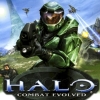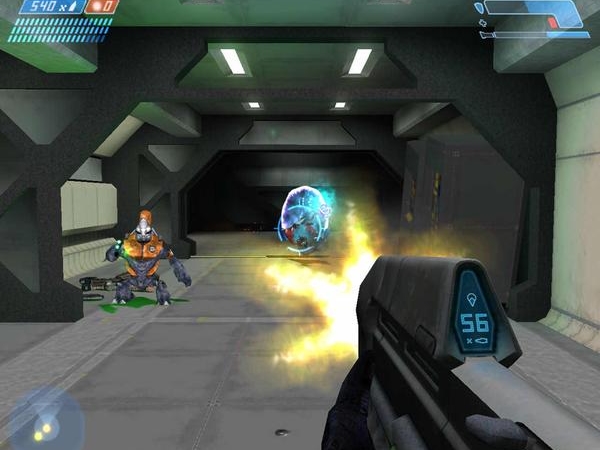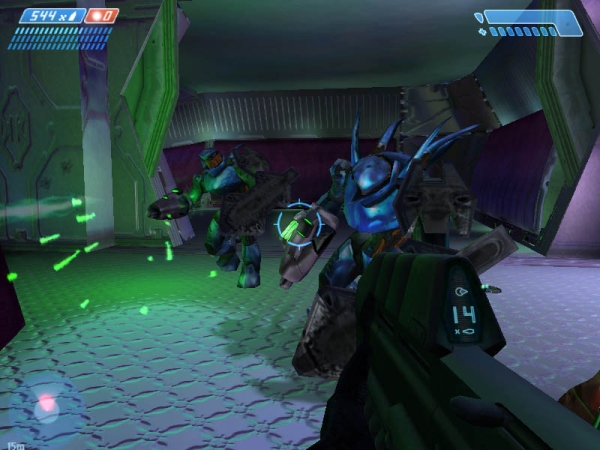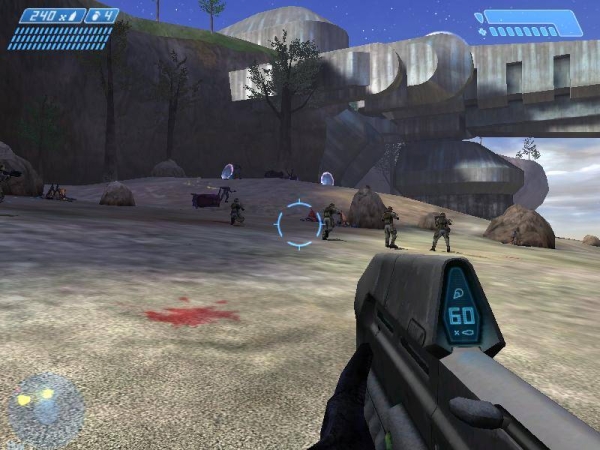Halo: Combat Evolved – A True FPS Rock Star
 To celebrate the release of Killzone 3, which we happen to think is a rather good first person shooter, a few of the writers here at GodisaGeek thought it would be idea to talk about their favourite FPS of all time. Let’s face it, we all love a good FPS, but there is always going to be that one title in the genre that holds a special place in our gaming hearts. Whether it be Duke Nukem or Call of Duty, Doom or Halo, every gamer out there has a personal favourite.
To celebrate the release of Killzone 3, which we happen to think is a rather good first person shooter, a few of the writers here at GodisaGeek thought it would be idea to talk about their favourite FPS of all time. Let’s face it, we all love a good FPS, but there is always going to be that one title in the genre that holds a special place in our gaming hearts. Whether it be Duke Nukem or Call of Duty, Doom or Halo, every gamer out there has a personal favourite.
The first writer stepping up to gush about his favourite FPS of all time is Mark Bridle. His choice? Halo: Combat Evolved.
First person shooters are fucking rock stars. Their launch parties attract celebrities quicker than a 50% discount on cocaine. Only the big sporting events like FIFA and Madden can get close to their sales figures and they attract controversy like Katy Price’s vagina. You and me could sit in a church whilst eating the throat out of a newborn baby and still piss off less people than next year’s inevitable Call of Duty sequel. When you are a big first person shooter, it just comes with the territory. Big publishers want the sales, console makers want to look cool and kids want to piss off their parents.
First Person Shooters. Rock. Fucking. Stars.
Now, of course, there is more than one type of rocker. Through the ages we have seen fresh faced youngsters, grizzled veterans, flawed geniuses, massive cocaine hoovers and Bono. Shooters are no different. Half Life is the virtuoso that releases a new album once a decade and changes the game for everybody else. Resistance: Fall of Man was the exciting new artist who went so unappreciated that their second album ended up copying everyone else. Killzone 2 was the first wave of Nu-Metal; in your face and violent, desperate to mix things up.
But, just like rock stars, some shooters get a little bit bigger and turn into full-blown, era-defining, first names only mega-fucking-stars. Clapton. Elvis. Springsteen.
Halo.
First person shooter royalty. Galactic Megastar.
For good reason.

Grunts, you gotta love 'em...or just shoot 'em!
Halo is nearly a decade old but, Cobain-like, the effects of its influence are still being felt today. Before Halo there were health bars, after Halo there were recharging shields. Before Halo player strategy was a mess, after Halo the world had changed. In the years before Bungie’s epic it was the case that fighting strategy was dictated by how much health the player had. Multiple saves had to be cultivated and managed in case an area was made too difficult by poor performance in previous areas. Slightly more surreptitiously, big set pieces and fights were often tipped off by the appearance of huge health and weapon caches, conveniently placed just before the massive creature or squad of super soldiers. Game structure, for all the attempts to get past the archaic days of “level-checkpoint-boss”, was trapped. Halo’s rechargeable shield set games free. Fighting and strategy was at the players discretion, independent of how they performed in the previous fight, and set pieces could be cloaked in secrecy. Big bosses and new enemies introduced without the developer revealing their hand by giving you access to a Cold War sized weapon and medical silo thirty seconds before meeting massive monster 1A.
Restricting players to two weapons just added layers to the tactical thinking. Before Halo, shooter players walked around like the stars in 80’s action movies; nine weapons and three types of grenade hanging off their back, armament choice dictated by ready ammunition and weapon power. Now players had to think more strategically by focussing on balancing their weapon combinations (no-one ever should get stuck with the Needler and the Plasma Pistol). Most exciting was that now developers could force players to experience the panic of fighting “left handed”. By putting the player in a long range fight without a sniper rifle or trapped up close and personal by a Hunter without a shotgun, challenge could be levied at the simply by designing levels that restricted the best weapon for a given scenario. Players could also be punished for doggedly hanging on to a favourite weapon well after its useful life expired. However, that punishment was never unfair because, by killing the nearest Covenant and stealing their gun, the balance of the fire fight could be redressed.

Two Hunters are always "better" than one!
The final piece of the puzzle was that enemy AI. Little enemy grunts running from you, shielded enemies playing an inch perfect game of nip and tuck behind their glowing protectors and the Elites, fighting you tooth and nail, recharging their shields, ducking in and out of cover, peppering you with plasma fire. It was a symphony of gunfire, a laser rock show, one that punished the player (always fairly) for relying on old tactics, but rewarded those players who targeted an enemy’s weakness, took out the big targets first and explored strategies like flanking or shifting sight lines by changing cover.
Thanks to all these design features, Halo’s challenge and spectacle was drawn from the inevitable chaos and drama of the firefights; amazing sights and sounds coming from the pure cause and effect of great game design. This excitement is a level beyond the one dimensional, scripted “marvels” of current FPSs; those set pieces seen in games like Call of Duty which fill the screen with graphics but offer little in terms of actual gameplay. The beautiful chaos of The Silent Cartographer; leaping from the helicopter, surrounded by squad mates and running into enemy fire, working along the beach then up into the centre of the island will always resonate more than Call of Duty’s Middle Eastern cities, primed to explode but always on the same cue.
My own love for Halo runs very deep. I dabbled with the Xbox version (mainly co-op with friends) but first met 343 Guilty Spark and saw the legendary plot twist on the PC version. As a PlayStation owner (with no funds for an Xbox) I thought that I would never get to play Halo on my own so when I heard about the PC release I ordered it instantly. The magic was still there, even on my old tube monitor. The pistol, with keyboard and mouse controls, remains the greatest virtual gun I have ever fired. Solid, punchy and accurate with enough stopping power for anything the game could throw at you, it was a fearsome beast. A recent run through Halo: Reach reunited me with that old friend and, though it felt slightly de-powered, it still maintained the stocky sound effect and punishing animation that makes me think it could fire a paper plane through a lead wall. It is always nice to see old friends.

Damn those marines are good!
Speaking of friends, I’m not big on making new ones. Especially online. I’m very much a single player animal. The lack of the Xbox Live multiplayer in Halo which became available in later releases was not felt. Halo encouraged getting together with friends for LAN parties, sharing beers, and was not only great fun but went a long way to de-nerdifying games and involving friends that previously would have avoided sharing my hobby. A truly stellar achievement for a space marines vs. aliens game set in the future on a giant ring in space.
Every great rock star needs a great riff, and Halo is no exception. The theme tune takes a leaf out of the Star Wars space opera manual (copyright Lucasarts, probably) and fills the game with the emotion, passion and desperation of the human struggle against the Covenant. It would have been easy for Bungie to fill their game with the raucous Nu-metal that was dominating the skating and gaming communities at the time, but (thankfully) they walked a higher path. I am a total sucker for the stirring patriotism and old fashioned themes of duty and honour and Halo latched onto those superbly. Combine those feelings with a terrific sci-fi story and, as George Lucas will tell you, things are probably going to end up going pretty well.
Halo also followed in Star Wars footsteps by telling an enthralling tale from a larger story. It is a shame that, at this point, it didn’t stop following the Star Wars model. Over following years the Halo saga became so convoluted that even the plot of Lost looks simple by comparison. Still, I’m not here to hammer the rest of the franchise, just to sing a loving power ballad to the original.
Never has a game been named so incorrectly, so modestly. Halo: Combat Evolved. This wasn’t evolution, this was full blown revolution. Evolution changes the world slowly, Halo’s revolution changed it overnight. Two weapon switching and a charging shield have changed the way games are designed. First person shooters weren’t changed so radically since the introduction of stairs, free form look and 3D models. The greatest rock stars don’t just define their own era; they go on to influence and effect everything that follows them, emblazoned onto the minds of everyone who ever gave a shit about quality, originality and doing something great.
That sounds like Bungie’s greatest, Halo: Combat Evolved to me. What a fucking rock star.




